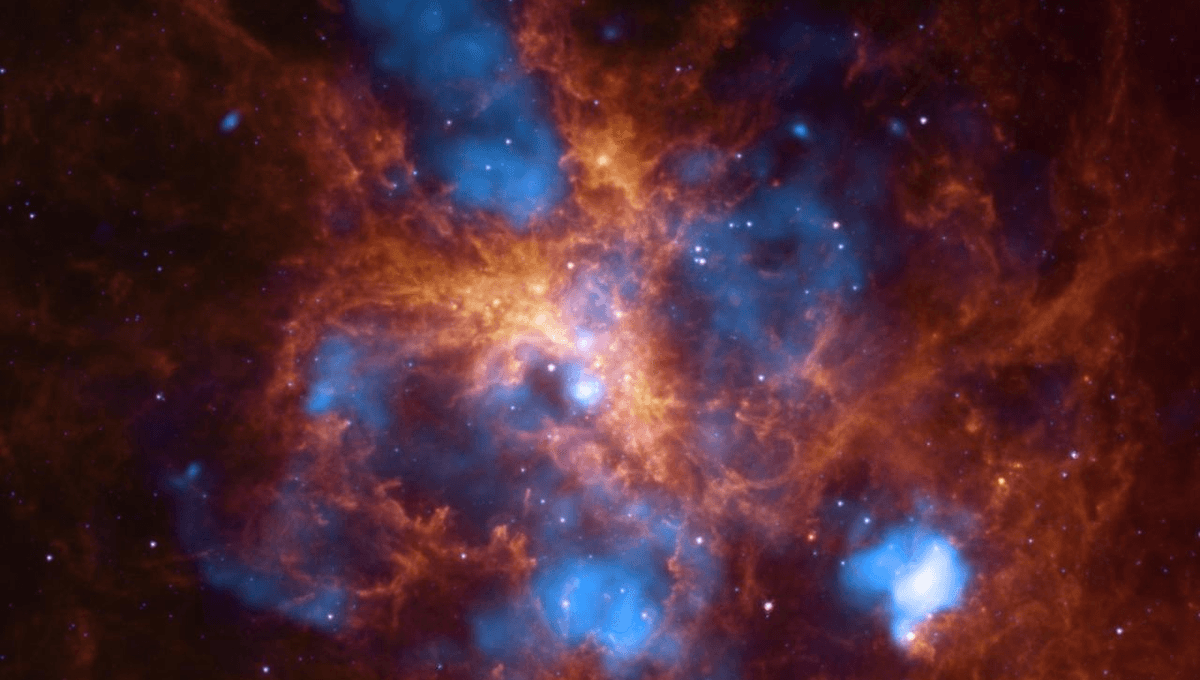
One of the great quests in astronomy is to find the first stars. These stars lived and died within a few hundred million years of the Big Bang, but for those in very distant parts of the universe, their light may only be reaching us now, having spent 14 billion years crossing the space between. At such a distance, it’s hard to spot a galaxy, let alone individual stars, yet many astronomers think we are getting close, thanks to the sheer size of some of these behemoths. So why did the early universe have stars so much bigger than any that exist today?
Before we answer that, a little background and explanation of terms. There are some truly immense stars today if we are talking about size, rather than mass. Famously, if the center of Betelgeuse was where the Sun is, its outer limits would stretch almost to Jupiter, making its radius nearly 1,000 times that of the Sun, and its volume close to a billion times bigger. Those figures are approximate, Betelgeuse’s constantly changing surface, which resembles a pot coming to the boil, is so hard to measure estimates vary by 30-40 percent, but there is no doubt it is very, very big.
Moreover, Betelgeuse is just our local supergiant, famous because it is relatively close. There are substantially larger stars, such as VY Canis Majoris.
However, while these stars have volumes far greater than the Sun, that is because they have puffed up as they run out of hydrogen near the ends of their lives. Mass is a more important measure of a star, and here the range is smaller. The most massive known stars in our galaxy contain around 125 solar masses. There are question marks over those estimates as well, since unless they have a companion star we can only measure mass rather indirectly. Nevertheless, there is generally considered to be a limit today between 100 and 200 solar masses.
Very few stars reach this – in fact, most stars have masses considerably less than the Sun.
So how is it that we are hunting “celestial monsters” thought to have 5,000-10,000 solar masses? Although not confirmed, a recent discovery of illuminated helium in the early universe makes most sense if it is being lit up by stars with masses 1,000 times that of the Sun – five to 10 times what is possible today.
The first stars (known as Population III) were formed entirely from hydrogen and helium along with a little lithium, lacking all the heavier elements that exist today, which are the products of previous stellar generations. These heavier elements, which astronomers call metals, usually make up a very small proportion of the stars’ starting mass, but it turns out those small impurities are very important.
The Big Bang is thought to have left behind gas clouds containing 1,000 solar masses or so at points where dark matter halos peaked. Atomic hydrogen is a very poor radiator of heat. When a gas cloud of pure hydrogen collapses it heats up as its gravitational potential energy turns to heat, eventually reaching the temperatures and pressures where fusion starts, creating a star. Not everyone agrees, but most astrophysicists think as long as the gas is a poor heat radiator, the entire cloud could condense into a single star, at least sometimes.
When patches of gas like that occur in the modern universe, such as in star formation regions like the Orion Nebula, the gas is mostly hydrogen, but contains a mix of metals, some of which are much better at radiating heat. That extra radiation means that patches of gas fragment long before they become stars, preventing the products from getting too large.
This doesn’t mean all the Population III stars were giants. One paper proposes the minimum was not far above 0.8 solar masses, thanks to the gas sometimes fragmenting into smaller pockets. That’s a lot larger than the current minimum size, where stars like Proxima Centauri, with 0.12 solar masses, are common. Nevertheless, it means most early stars were well within the range we are familiar with.
Even so, it seems the saying “there were giants in those days”, while inaccurate for humanity’s prehistory, was true for stars. A small proportion of the early stars were truly enormous. Since stellar luminosity goes up, for main sequence stars, by more than the cube of the mass, we might expect a star 1,000 times as massive as the sun to be more than a billion times as bright. In fact, this relationship breaks down for stars more than 55 times the mass of the Sun.
Consequently, a 1,000 solar masses star would outshine our Sun by more like 3 million times. That’s still more than enough for a tiny minority of the first stars to have an outsize impact on galaxy formation, and perhaps be visible over billions of light years.
Source Link: Why Were The First Stars So Enormous?